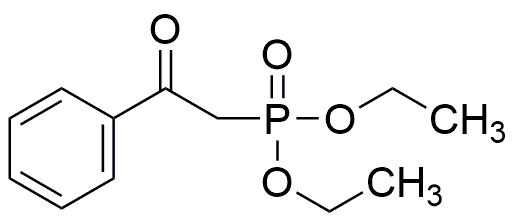Diethyl (2-oxo-2-phenylethyl)phosphonate is widely utilized in research focused on:
- Pharmaceutical Development: This compound serves as an important intermediate in the synthesis of various pharmaceuticals, particularly in the development of anti-cancer agents and other therapeutic drugs.
- Agricultural Chemistry: It is used in the formulation of pesticides and herbicides, enhancing crop protection and yield by targeting specific pests while minimizing environmental impact.
- Material Science: The compound is employed in the creation of specialty polymers and coatings, providing improved durability and resistance to chemical degradation compared to traditional materials.
- Organic Synthesis: It acts as a versatile reagent in organic synthesis, facilitating the formation of complex molecules with high efficiency, which is crucial for researchers in synthetic chemistry.
- Analytical Chemistry: This chemical is utilized in analytical methods for detecting and quantifying phosphonate compounds, aiding researchers in environmental monitoring and quality control.
General Information
Properties
Safety and Regulations
Applications
Diethyl (2-oxo-2-phenylethyl)phosphonate is widely utilized in research focused on:
- Pharmaceutical Development: This compound serves as an important intermediate in the synthesis of various pharmaceuticals, particularly in the development of anti-cancer agents and other therapeutic drugs.
- Agricultural Chemistry: It is used in the formulation of pesticides and herbicides, enhancing crop protection and yield by targeting specific pests while minimizing environmental impact.
- Material Science: The compound is employed in the creation of specialty polymers and coatings, providing improved durability and resistance to chemical degradation compared to traditional materials.
- Organic Synthesis: It acts as a versatile reagent in organic synthesis, facilitating the formation of complex molecules with high efficiency, which is crucial for researchers in synthetic chemistry.
- Analytical Chemistry: This chemical is utilized in analytical methods for detecting and quantifying phosphonate compounds, aiding researchers in environmental monitoring and quality control.
Documents
Safety Data Sheets (SDS)
The SDS provides comprehensive safety information on handling, storage, and disposal of the product.
Product Specification (PS)
The PS provides a comprehensive breakdown of the product’s properties, including chemical composition, physical state, purity, and storage requirements. It also details acceptable quality ranges and the product's intended applications.
Certificates of Analysis (COA)
Search for Certificates of Analysis (COA) by entering the products Lot Number. Lot and Batch Numbers can be found on a product’s label following the words ‘Lot’ or ‘Batch’.
Numéro de catalogue
Numéro de lot/série
Certificates Of Origin (COO)
This COO confirms the country where the product was manufactured, and also details the materials and components used in it and whether it is derived from natural, synthetic, or other specific sources. This certificate may be required for customs, trade, and regulatory compliance.
Numéro de catalogue
Numéro de lot/série
Safety Data Sheets (SDS)
The SDS provides comprehensive safety information on handling, storage, and disposal of the product.
DownloadProduct Specification (PS)
The PS provides a comprehensive breakdown of the product’s properties, including chemical composition, physical state, purity, and storage requirements. It also details acceptable quality ranges and the product's intended applications.
DownloadCertificates of Analysis (COA)
Search for Certificates of Analysis (COA) by entering the products Lot Number. Lot and Batch Numbers can be found on a product’s label following the words ‘Lot’ or ‘Batch’.
Numéro de catalogue
Numéro de lot/série
Certificates Of Origin (COO)
This COO confirms the country where the product was manufactured, and also details the materials and components used in it and whether it is derived from natural, synthetic, or other specific sources. This certificate may be required for customs, trade, and regulatory compliance.

